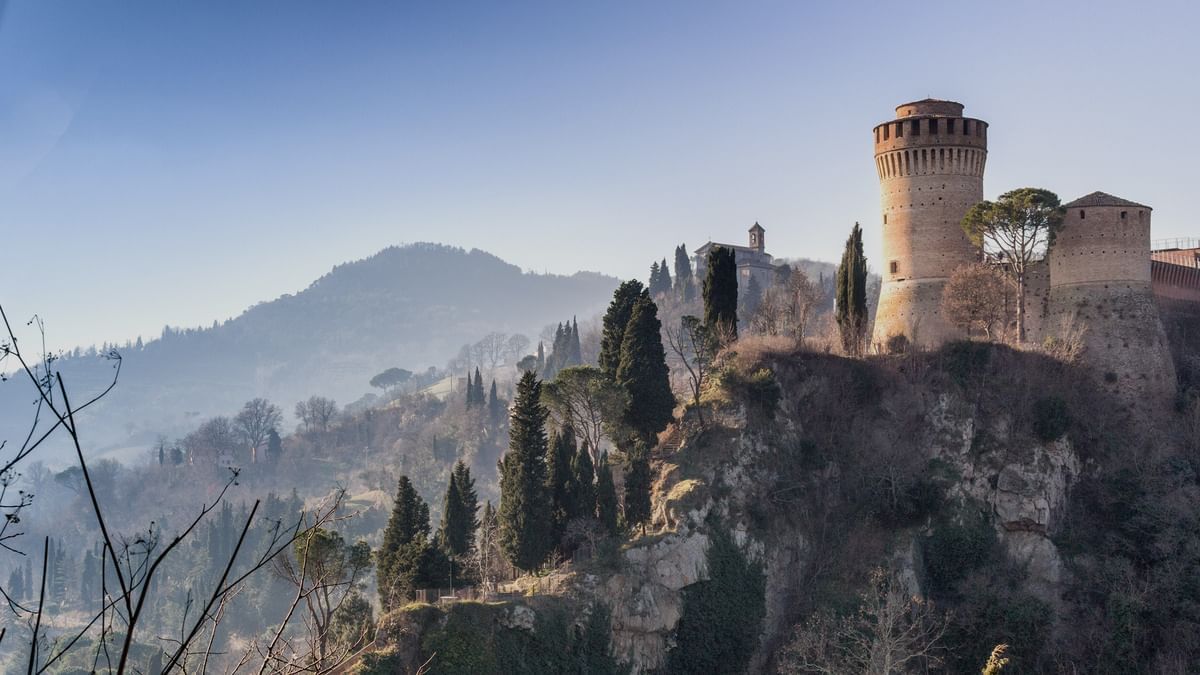These small jewels are ideal destinations for a daytrip to a place where time seems to stand still.
28 Nov 2020
Gruppo UNA
The many uniquely-beautiful small medieval villages around Bologna are perfect places for a getaway, a trip back to the olden days, immersed in stunning natural landscapes in the hills or on the plains. Ready to come with us? Off we go then, here’s your list of some of the most unusual small towns to visit near Bologna.
Brisighella and her three guardians.
The medieval village of Brisighella is like a time machine. The first thing you notice when you arrive are three imposing rocky pinnacles, known as “the three hills”, overlooking the small town. Each one of them is a protective “guardian”: the Manfredian fortress, the sanctuary of Monticino, and the Clock Tower. In the village centre, the delightful Piazza Marconi is surrounded by small houses. Despite their bright pastel colours, the houses conceal a secret: if you lean out from the arched windows overlooking the square, behind the facades you can make out an old, now covered-over, elevated street known as the Via degli Asini. Initially built in the fourteenth century for defensive purposes, in time this small road was covered over and incorporated into the surrounding dwellings. Back in the day, it was used principally by carters and their donkeys to transport chalk from the quarries above the village, hence the name.

Dozza and its open-air art gallery.
The small town of Dozza, a medieval village of rare beauty that straddles a hilltop ridge, nestles in the verdant Tuscan-Romagna Apennines. The village may have only a thousand inhabitants, but that is supplemented by an impressive cast of characters on the village’s walls. Indeed, Dozza is a veritable open-air art gallery, with over a hundred paintings on shops and houses to keep you company as you walk through its pretty streets.
It’s all down to the Biennale del Muro Dipinto [Biennial of the Painted Wall], which since the 1960s has attracted hundreds of contemporary artists, who have transformed Dozza’s small houses into tiny works of art.
Scola and its cypress.
One of the best-preserved villages in the Bolognese Apennines, the enchanting medieval hamlet of Scola dates back to the fourteenth century. To visit here is to immediately feel transported back to another era, to happen by chance upon a secret place. The fortified village was first built as a military quarter and a place of resistance and defense for the monastic centre at Montovolo, which was not just of religious importance but of economic and commercial significance as well. Around Montovolo, near the border with the Longobards, legendary battles were waged between Frankish warriors known as the Paladins and the invading Longobards. The fortified village played a strategic role in all this, its military function justifying both its name and urban disposition. It is an excellent place to lose oneself in the narrow village streets, and perhaps go hunting for the many symbols left behind by builders and artists on the walls of the houses. Don’t miss Scola’s majestic cypress: 25 m tall, it is estimated to be over 700 years old and is a veritable monument of nature.

The tiny village of Borgo di San Pietro.
The tiny village of San Pietro is located on the edge of the beautiful Bolognese Gypsum Regional Park. Like other medieval villages in the area, San Pietro was founded with strategic and defensive functions in mind. There used to be a castle here, one of the links in the chain of fortresses built in medieval times to defend the Via Emilia. Remains from that period include a beautiful, restored tower which was once part of the castle walls.
Two churches lay within the walls: the Church of San Lorenzo, and the Church of San Pietro. Only the latter is still standing. The final witnesses of this age-old village are two fountains, known as the “Fountains of Arms”.


Selva Malvezzi: a small world of its own.
A veritable feudal complex, the fifteenth-century village of Selva Malvezzi owes its name to a powerful Bolognese noble family. Restored in the seventeenth century, the whole village has preserved its original appearance, with a seventeenth-century mansion and the Governor’s Palace at its heart. The Palace’s splendid facade is enhanced by a clock and a bell. The “palazzaccio” medieval stronghold is unfortunately partly ruined, but the village remains a small world of its own, set on the verdant Bolognese plain.
Where to stay in Bologna.
We offer two places to stay that are perfect for discovering Bologna and its surroundings. The first is ideal if you also want to visit beautiful Bologna: UNAHOTELS Bologna Centro is a great place to fully enjoy the city’s atmosphere. Meticulously decorated to showcase Italian style and charm, the hotel is located right in the heart of the town, making it a perfect start to your tour. Alternatively, if you already know Bologna well and are looking for a strategic location to explore the Emilia-Romagna region, UNAHOTELS San Vitale Bologna is for you, tucked handily between Bologna’s lively old town and its main communications routes.



